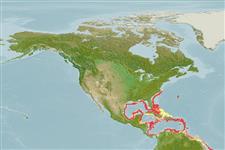>
Anguilliformes (Eels and morays) >
Nettastomatidae (Duckbill eels)
Etymology: Nettenchelys: Greek, netta = duck + Greek, enchelys, -yos = eel (Ref. 45335); pygmaea: Named after the Greek pygmaios meaning small, dwarf, referring to the small size of the adults..
Environment: milieu / climate zone / depth range / distribution range
Ecologia
marinhas batidemersal; intervalo de profundidade 128 - 280 m (Ref. 37039). Tropical
Western Central Atlantic: northern Gulf of Mexico and off Venezuela. Probably fairly widely distributed in the western Atlantic (Ref. 40819).
Comprimento de primeira maturação / Tamanho / Peso / Idade
Maturity: Lm 17.5, range 15 - 20 cm
Max length : 20.1 cm TL macho/indeterminado; (Ref. 37039)
Vértebras: 220 - 250. Anterior median vomerine teeth enlarged. Posterior nostril on top of head just behind posterior margin of eye. Mature at 15-20 cm TL. Other characteristics: Color brown, slightly darker dorsally than ventrally. Lateral line pores to anus number 40-42 (Ref. 37039).
Ciclo de vida ou comportamento de acasalamento
Maturities | Reprodução | Spawnings | Egg(s) | Fecundities | Larvas
McEachran, J.D. and J.D. Fechhelm, 1998. Fishes of the Gulf of Mexico. Volume 1: Myxiniformes to Gasterosteiformes. University of Texas Press, Austin. 1112p. (Ref. 37039)
Status na Lista Vermelha da UICN (Ref. 130435)
Ameaça para os humanos
Harmless
Uso pelos humanos
Ferramentas
Relatórios especiais
Baixar XML
Fontes da internet
Estimates based on models
Preferred temperature (Ref.
123201): 14.7 - 23.2, mean 18.6 °C (based on 31 cells).
Índice de diversidade filogenética (Ref.
82804): PD
50 = 0.5039 [Uniqueness, from 0.5 = low to 2.0 = high].
Bayesian length-weight: a=0.00089 (0.00036 - 0.00223), b=2.98 (2.77 - 3.19), in cm total length, based on LWR estimates for this (Sub)family-body shape (Ref.
93245).
Nível Trófico (Ref.
69278): 3.3 ±0.4 se; based on size and trophs of closest relatives
Resiliência (Ref.
120179): Elevada, tempo mínimo de duplicação da população menor que 15 meses (Preliminary K or Fecundity.).
Fishing Vulnerability (Ref.
59153): Low vulnerability (10 of 100).
